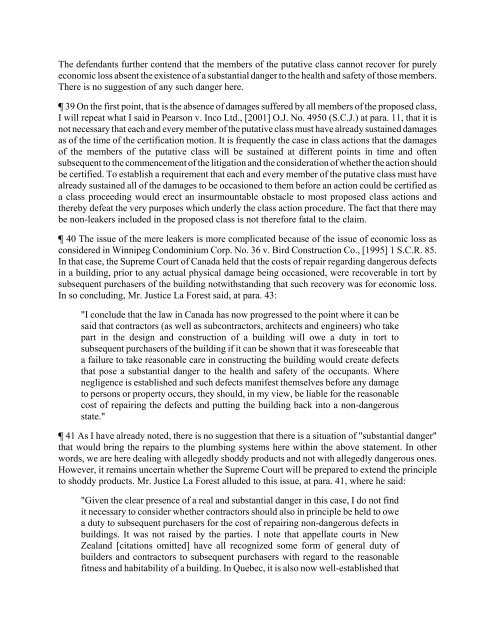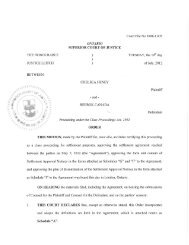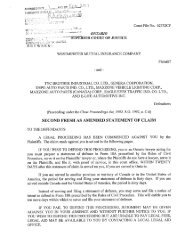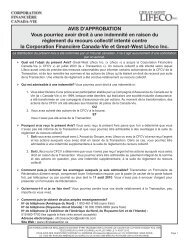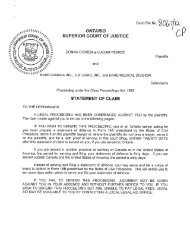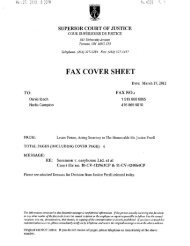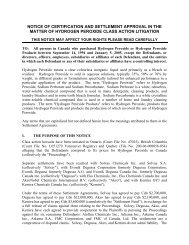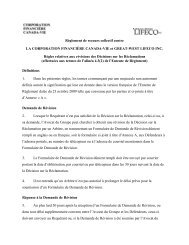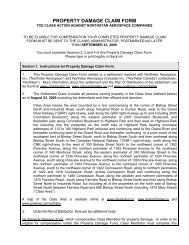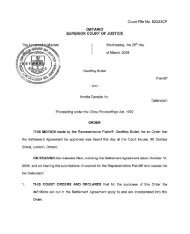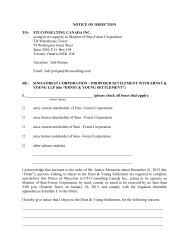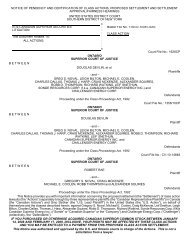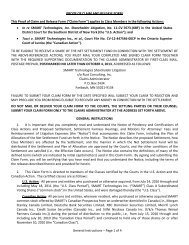Gariepy v. Shell Oil Co. - Classaction.ca
Gariepy v. Shell Oil Co. - Classaction.ca
Gariepy v. Shell Oil Co. - Classaction.ca
You also want an ePaper? Increase the reach of your titles
YUMPU automatically turns print PDFs into web optimized ePapers that Google loves.
The defendants further contend that the members of the putative class <strong>ca</strong>nnot recover for purelyeconomic loss absent the existence of a substantial danger to the health and safety of those members.There is no suggestion of any such danger here. 39 On the first point, that is the absence of damages suffered by all members of the proposed class,I will repeat what I said in Pearson v. Inco Ltd., [2001] O.J. No. 4950 (S.C.J.) at para. 11, that it isnot necessary that each and every member of the putative class must have already sustained damagesas of the time of the certifi<strong>ca</strong>tion motion. It is frequently the <strong>ca</strong>se in class actions that the damagesof the members of the putative class will be sustained at different points in time and oftensubsequent to the commencement of the litigation and the consideration of whether the action shouldbe certified. To establish a requirement that each and every member of the putative class must havealready sustained all of the damages to be oc<strong>ca</strong>sioned to them before an action could be certified asa class proceeding would erect an insurmountable obstacle to most proposed class actions andthereby defeat the very purposes which underly the class action procedure. The fact that there maybe non-leakers included in the proposed class is not therefore fatal to the claim. 40 The issue of the mere leakers is more compli<strong>ca</strong>ted be<strong>ca</strong>use of the issue of economic loss asconsidered in Winnipeg <strong>Co</strong>ndominium <strong>Co</strong>rp. No. 36 v. Bird <strong>Co</strong>nstruction <strong>Co</strong>., [1995] 1 S.C.R. 85.In that <strong>ca</strong>se, the Supreme <strong>Co</strong>urt of Canada held that the costs of repair regarding dangerous defectsin a building, prior to any actual physi<strong>ca</strong>l damage being oc<strong>ca</strong>sioned, were recoverable in tort bysubsequent purchasers of the building notwithstanding that such recovery was for economic loss.In so concluding, Mr. Justice La Forest said, at para. 43:"I conclude that the law in Canada has now progressed to the point where it <strong>ca</strong>n besaid that contractors (as well as subcontractors, architects and engineers) who takepart in the design and construction of a building will owe a duty in tort tosubsequent purchasers of the building if it <strong>ca</strong>n be shown that it was foreseeable thata failure to take reasonable <strong>ca</strong>re in constructing the building would create defectsthat pose a substantial danger to the health and safety of the occupants. Wherenegligence is established and such defects manifest themselves before any damageto persons or property occurs, they should, in my view, be liable for the reasonablecost of repairing the defects and putting the building back into a non-dangerousstate." 41 As I have already noted, there is no suggestion that there is a situation of "substantial danger"that would bring the repairs to the plumbing systems here within the above statement. In otherwords, we are here dealing with allegedly shoddy products and not with allegedly dangerous ones.However, it remains uncertain whether the Supreme <strong>Co</strong>urt will be prepared to extend the principleto shoddy products. Mr. Justice La Forest alluded to this issue, at para. 41, where he said:"Given the clear presence of a real and substantial danger in this <strong>ca</strong>se, I do not findit necessary to consider whether contractors should also in principle be held to owea duty to subsequent purchasers for the cost of repairing non-dangerous defects inbuildings. It was not raised by the parties. I note that appellate courts in NewZealand [citations omitted] have all recognized some form of general duty ofbuilders and contractors to subsequent purchasers with regard to the reasonablefitness and habitability of a building. In Quebec, it is also now well-established that


